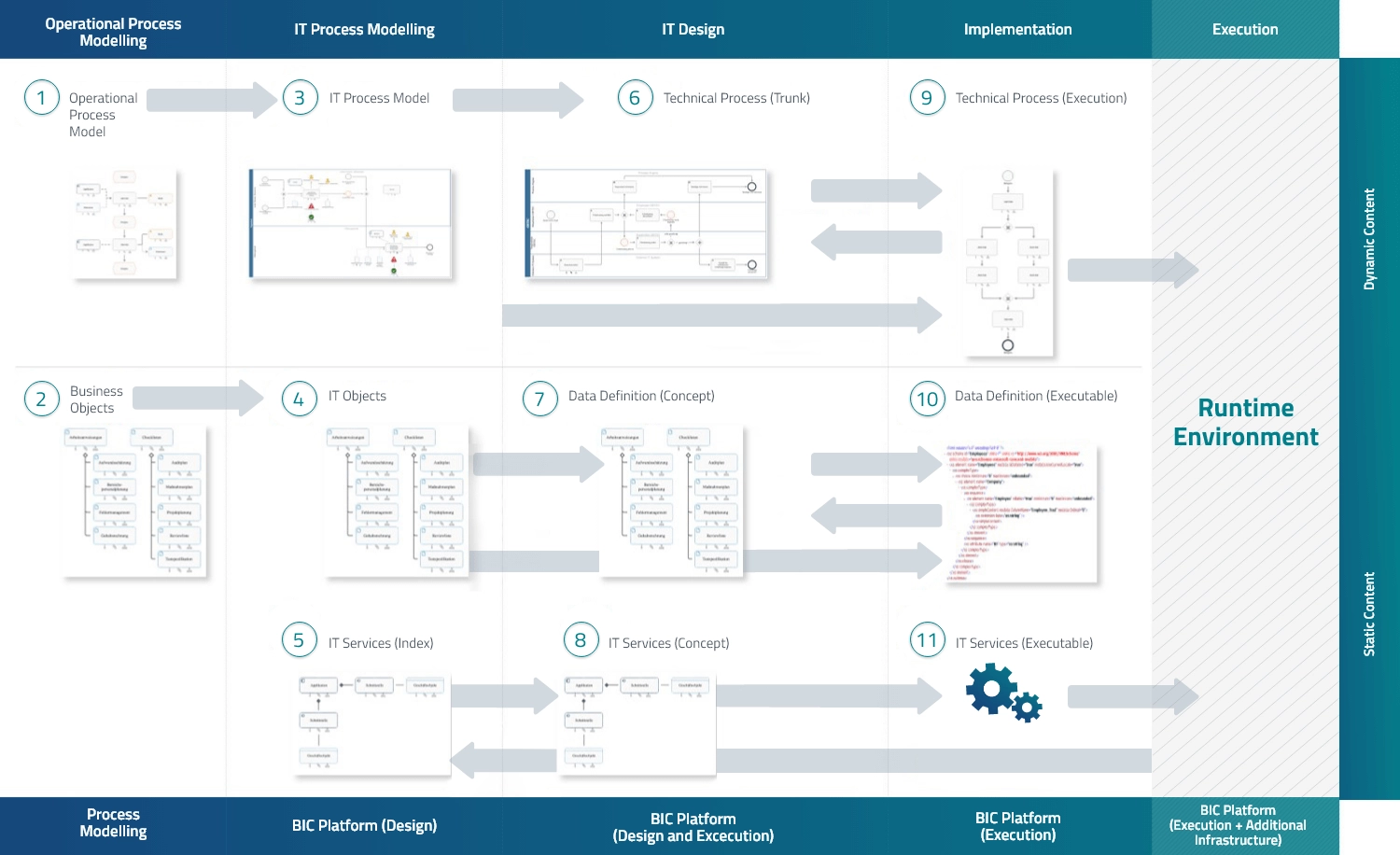BIC Process Design
Understand & Transform
Supercharge your business operations with the most intuitive AI-powered BPM software.
It seems that you come from a German speaking country. Here you can change the language
EnglishWhen it comes to digitalization, process management and automation make the task considerably easier. The transparency that they provide to business processes and the IT landscape, including evaluation/assessment and automation, lays the groundwork for rapid and efficient digital transformation.

No matter where you get your business or technology-oriented news these days, much of the information revolves around digitalization. But digitalization is not an aim unto itself. Behind all of the activity involved, its goals are the generation of new products and services for customers as well as increased efficiency. And intrinsically involved in this procedure are all of the various operations that take place within an organization – the “processes”. Whether it be documentation of financial processes required by an ICS or the desire for an ISO-compliant implementation of process-oriented quality management or a recommendation from IT for the automation of operational tasks, the need quickly arises for functional Business Process Management (BPM).
Various perspectives exist for describing business processes. Operational business process models are used to optimize operational activities within a company or between business partners, while process automation models can be used for technical planning, implementation, and control of corporate information systems. Each of these approaches targets a different goal, but they can easily be combined through use of the tools included in the BIC family of products, thereby enabling both operational business process management as well as process automation. Before presenting potential scenarios for combining operational and technical modeling, it is necessary to first explain
the fundamental interrelationship between business process models and automation models. Figure 1 shows the various phases and interrelationships involved in moving from process modeling to automation. Of particular consideration are the following phases: Operational Process Modeling, IT Process Modeling, IT Design, Implementation, and Execution. In each of these phases, it is important to distinguish between dynamic and static content. Dynamic content includes information regarding timed logistical processes; in contrast, static content generally consists of definitions of the business objects or data objects being processed as well as professional or technical services.

In the course of operational process modeling, all of the activities involved in a business process will be presented from a business management perspective (1), meaning that the model will focus on the business management information needed by the target groups. These groups are generally specialist departments who will be using the results to design an organizational work domain. At this level, along with the processes themselves, a definition of the business objects involved is included (2). It is important to note that at this stage in the modeling, this is still a purely functional definition, and is not related to IT. When operating with BIC in this phase, the EPC and BPMN models are used to define dynamic content, while static content is defined by the structure diagram.
The operational process modeling that has now been generated is generally not suitable for immediate implementation. Rather, experience gained over the course of many projects has shown that implementation will succeed only if IT process modeling is undertaken as an intermediary step. Here, it is important to ensure that there be absolutely no semantic smearing of operational and IT-specific content within one individual model. This would sharply restrict the usefulness of the models in both areas of application. For this reason, a loose coupling between the operational (1) and the IT-specific process modeling (3) is recommended. This separation should also be maintained for the static content. This means that business objects that have been defined from an operational perspective (2), such as a customer order, will, in this step, be refined to an IT object (4). In this same step, IT-supported activities will be linked to support services (5).
The technological solution will be drafted during the IT design phase. In this phase, appropriate automation models (6), data definitions (7), and the associated IT services will be designed, based on the IT process and object models (3 and 4). For representing the content mentioned above, BIC Platform includes, along with BPMN, ArchiMate notation. This allows the definition of still more complex interrelationships within a target system’s IT architecture.
Following operational modeling, IT-specific modeling, and the resulting IT design, implementation of the future solution can take place, meaning that the executable processes (9), the data definitions (10), and the IT services will be finalized. For this, BIC Process Execution provides a comprehensive development platform that, on the basis of technical BPMN diagrams, implements solutions all the way through to successful running of the application.
In the final step, during the execution phase, the solution that has been developed will be put into operation within the customer-determined run-time environment and infrastructure.
Following this description of how the fundamental approach from classical process management to process automation takes place, an explanation of the BIC Platform methodology is required. It should be noted that for digitalization, not all of the artifacts described necessarily need to be modeled. A fundamental distinction can be made between top-down and mixed integration.
Top-down integration refers to an implementation in which no information from the final operational solution is returned to the modeling process. In contrast, mixed integration, in addition to using the top-down approach, also includes a bottom-up return route for information from an implemented solution in order to achieve fully- or partially-automated modeling in the modeling process.
| Dynamic Modeling | Static Modeling | |||
| Task Sequence | Phases | Description | Phases | Description |
| 1 | 0 › 1 | Modeling of the operational process models using EPC or BPMN | 0 › 2 | Modeling of the business objects using structure diagrams |
| 2 | 1 › 3 | Creation of IT process model through detailing individual activities from the operational business process model using EPC or BPMN and indentification of professional services required | 2 › 4 | Creation of technical IT objects through detailing of the business objects, using structure diagrams or the IT architecture |
| 3 | 3 > 9 | Creation of an BPMN process on the basis of the IT process model that has been generated | 4 > 10 | Creation of technical data definitions based on the technical IT object definitions generated |
| 5 > 11 | Implementation of professional services identified | |||
| 4 | 9 > 12 | Transfer of the executable BPMN process to the run-time environment | 10 > 13 | Transfer of the data definitions to the run-time environment |
| 11 > 14 | Transfer of the services implemented to the run-time environment | |||
Table 1: Steps in Top-Down Integration
| Dynamic Modeling | Static Modeling | |||
| Task Sequence | Phases | Description | Phases | Description |
| 1 | 0 › 1 | Modeling of the operational process models using EPC or BPMN | 0 › 2 | Modeling of the business objects using structure diagrams |
| 2 | 1 › 3 | Creation of IT process model through detailing individual activities from the operational business process model using EPC or BPMN and indentification of professional services required | 2 › 4 | Creation of technical IT objects through detailing of the business objects, using structure diagrams or the IT architecture |
| 3 | 3 > 6 | Creation of BPMN process skeletons based on the IT process created | 4 > 7 | Creation of technical data definitions based on the technical IT object definitions generated |
| 5 > 8 | Draft of the services required based on the identification, with the aid of ArchiMate notation, of professional service needed | |||
| 4 | 6 > 9 | Automated transfer of the BPMN skeletons for finalization in the BIC Process Execution development environment | 7 > 10 | Generation of data definitions based on the technical data definitions |
| 8 > 11 | Generation of services required based on the BPMN diagram created | |||
| 5 | 9 > 12 | Transfer of the executable BPMN processes to the run-time environment | 10 > 13 | Transfer of the data definitions created to the run-time evironment |
| 8 > 11 | Transfer of the services implemented to the run-time evironment | |||
| 6 | 9 > 6 | Inputting of the BPMN processes, now expanded with technical implementation information, into the modeling tool | 10 > 7 | Inputting of the data definitions, now expanded with technical implementation information, into the operational modeling tool |
| 14 > 5 | Automatic updating of the service repositories with the new, professionally-relevant services | |||
Table 2: Steps in Mixed Integration
With BIC Platform you make the most of your processes. With a flexible use of our modules, you reach a holistic, highly effective digital transformation in your company.






Head of GBTEC Academy
Christoph isn’t just the head of our GBTEC Academy – he also brings years of experience and deep expertise across our entire product portfolio. For many years, he worked closely with our customers as a consultant. Today, he and his team provide not only product-specific trainings but also help companies and professionals strengthen their skills in a wide range of topics, even beyond our own product offerings.
We have the information you need to unleash your full process potential. Take a look at our resources and start improving your business performance today.